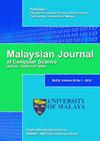CLUSTERING AND INDEXING OF MULTIPLE DOCUMENTS USING FEATURE EXTRACTION THROUGH APACHE HADOOP ON BIG DATA
IF 1.2
4区 计算机科学
Q4 COMPUTER SCIENCE, ARTIFICIAL INTELLIGENCE
引用次数: 4
Abstract
Bigdata is a challenging field in data processing since the information is retrieved from various search engines through internet. A number of large organizations, that use document clustering,fails in arranging the documents sequentially in their machines. Across the globe, advanced technologyhas contributed to the high speed internet access. But the consequences of useful yet unorganized information in machine files seemto be confused in the retrieval process. Manual ordering of files has its own complications. In this paper, application software like Apache Lucene and Hadoop have taken a lead towards text mining for indexing and parallel implementation of document clustering. In organizations, it identifies the structure of the text data in computer files and its arrangement from files to folders, folders to subfolders, and to higher folders. A deeper analysis of document clustering was performed by considering various efficient algorithms like LSI, SVD and was compared with the newly proposed updated model of Non-Negative Matrix Factorization. The parallel implementation of hadoopdevelopedautomatic clusters for similar documents. MapReduce framework enforced its approach using K-means algorithm for all the incoming documents. The final clusters were automatically organized in folders using Apache Lucene in machines. This model was tested by considering the dataset of Newsgroup20 text documents. Thus this paper determines the implementation of large scale documents using parallel performance of MapReduce and Lucenethat generate automatic arrangement of documents, which reduces the computational time and improves the quick retrieval of documents in any scenario.基于apachehadoop的大数据特征提取对多个文档的聚类和索引
大数据是数据处理中一个具有挑战性的领域,因为信息是通过互联网从各种搜索引擎中检索的。许多使用文档集群的大型组织无法在其机器中按顺序排列文档。在全球范围内,先进的技术为高速互联网接入做出了贡献。但是,在检索过程中,机器文件中有用但无组织的信息的后果似乎是混淆的。手动排序文件有其自身的复杂性。在本文中,像ApacheLucene和Hadoop这样的应用软件已经率先实现了文本挖掘,用于索引和文档集群的并行实现。在组织中,它标识计算机文件中文本数据的结构及其从文件到文件夹、从文件夹到子文件夹以及到更高文件夹的排列。通过考虑LSI、SVD等各种有效算法,对文档聚类进行了更深入的分析,并与新提出的非负矩阵分解模型进行了比较。hadoop的并行实现为类似文档开发了自动集群。MapReduce框架使用K-means算法对所有传入文档强制执行其方法。最后的集群在机器中使用ApacheLucene自动组织在文件夹中。该模型通过考虑Newsgroup20文本文档的数据集进行了测试。因此,本文确定了使用MapReduce和Lucenthat的并行性能来实现大规模文档的自动排列,这减少了计算时间,提高了在任何场景下对文档的快速检索。
本文章由计算机程序翻译,如有差异,请以英文原文为准。
求助全文
约1分钟内获得全文
求助全文
来源期刊

Malaysian Journal of Computer Science
COMPUTER SCIENCE, ARTIFICIAL INTELLIGENCE-COMPUTER SCIENCE, THEORY & METHODS
CiteScore
2.20
自引率
33.30%
发文量
35
审稿时长
7.5 months
期刊介绍:
The Malaysian Journal of Computer Science (ISSN 0127-9084) is published four times a year in January, April, July and October by the Faculty of Computer Science and Information Technology, University of Malaya, since 1985. Over the years, the journal has gained popularity and the number of paper submissions has increased steadily. The rigorous reviews from the referees have helped in ensuring that the high standard of the journal is maintained. The objectives are to promote exchange of information and knowledge in research work, new inventions/developments of Computer Science and on the use of Information Technology towards the structuring of an information-rich society and to assist the academic staff from local and foreign universities, business and industrial sectors, government departments and academic institutions on publishing research results and studies in Computer Science and Information Technology through a scholarly publication. The journal is being indexed and abstracted by Clarivate Analytics'' Web of Science and Elsevier''s Scopus
 求助内容:
求助内容: 应助结果提醒方式:
应助结果提醒方式:


